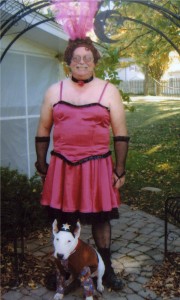While Halloween is a fun night for many, it can be extremely scary for our four-legged friends. We’re sharing some tips to help keep your pet safe and sound, allowing your family to enjoy all of the fun of a day of dress-up. Thanks to all of the folks at the ASPCA and AKC for some helpful suggestions!
Look what I’ve got in my trick-or-treat bag! Look, but don’t share (at least not with Fido or Fluffy); Halloween treats can be harmful to our pets. Canine and feline digestive systems are not meant for sweets, resulting in an upset tummy at best. Chocolate in all forms—especially dark or baking chocolate—can be very dangerous for dogs and cats; it contains theobromine, which can be fatal to our dogs. Candies containing the artificial sweetener xylitol can also cause problems. Plan on taking your walks earlier in the day, when lighting is best–dropped candies, wrappers, broken eggs, and other Halloween debris can be harmful if ingested. If you do suspect your pet has ingested something potentially toxic, please call our office or the ASPCA Animal Poison Control Center at (888) 426-4435.
Decorating is fun! Popular Halloween plants such as pumpkins and decorative corn are considered to be relatively nontoxic, but they can produce stomach upset in pets who nibble on them. More problematic are wires and cords from electric lights and other decorations, which should be kept out of reach of your pets. If chewed, your pet might suffer cuts or burns, or receive a possibly life-threatening electrical shock. A carved pumpkin certainly is festive, but do exercise caution if you choose to add a candle. Pets can easily knock a lit pumpkin over and cause a fire. Curious kittens especially run the risk of getting burned or singed by candle flames.
What are you going to be for Halloween this year? Dress-up can be a big mess-up for some pets. Please don’t put your dog or cat in a costume UNLESS you know he or she loves it (yup, a few pets are real hams!). For pets who prefer their “birthday suits,” however, wearing a costume may cause undue stress. If you do dress up your pet, make sure the costume isn’t annoying or unsafe. It should not constrict the animal’s movement or hearing, or impede his ability to breathe, bark or meow. Also, be sure to try on costumes before the big night. If your pet seems distressed, allergic or shows abnormal behavior, consider letting him go au naturale or donning a festive bandana. Take a closer look at your pet’s costume and make sure it does not have small, dangling or easily chewed-off pieces that he could choke on. Also, ill-fitting outfits can get twisted on external objects or your pet, leading to injury.
There’s a witch at my door! When answering the door for trick or treaters, take care that your dog or cat does not dart or scoot outside. All but the most social dogs and cats should be kept in a separate room away from the front door during peak trick-or-treating hours. Too many strangers can be scary and stressful for pets, and joyful children in costumes are sometimes much scarier to our pets than they are to us. Always make sure your dog or cat has proper identification. If for any reason your pet escapes and becomes lost, a collar and tags and/or a microchip can be a lifesaver, increaing the chances that he or she will be returned to you. This is the day to forget to take that collar off when you come in from your walk–at least during the trick or treating hours.
As always, be safe and have fun. If you do dress your pet, please share his photo with us on Facebook–we love to see our patients and their families at their happiest! Happy Halloween!

